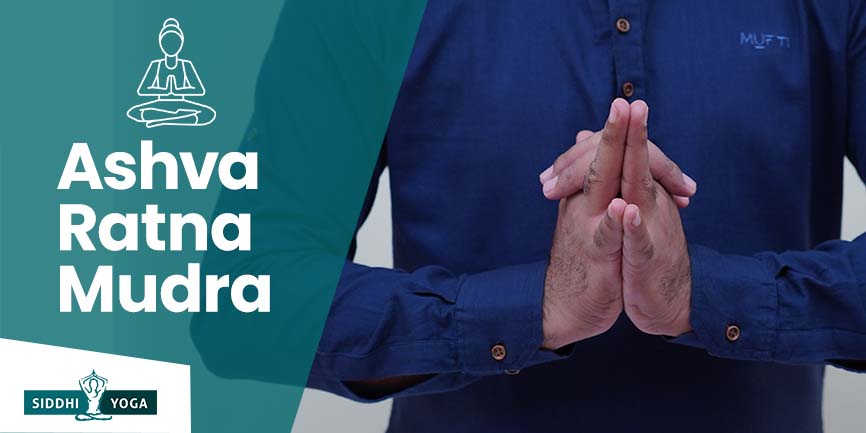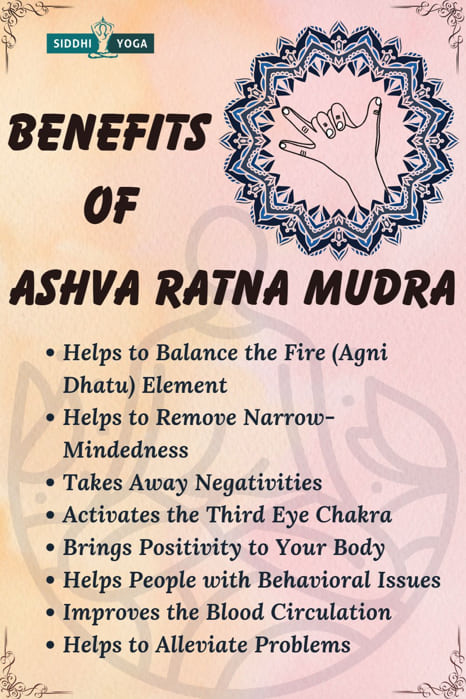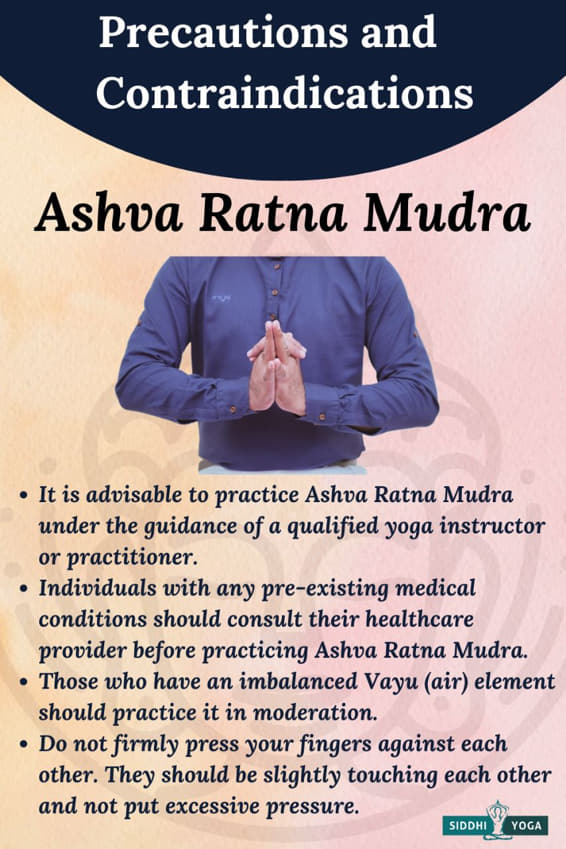
The Ashva Ratna Mudra is an important hand gesture in yoga. Discover its meaning, benefits, and how to do it correctly in this comprehensive guide.
Definition – What is Ashva Ratna Mudra and its Meaning, References, and Mythology?
Ashva Ratna Mudra is a type of hand gesture or seal. It can be translated into a Horse Jewel Gesture/seal. Some people also name it the horse carrying a wish-fulfilling jewel.
In Indian and neighboring mythologies, a Windhorse can be found with jewels. The jewel that it carries is known for prosperity, harmony & wealth. The wind horse is seen as a symbol of purity.
It opens a door to prospering life and removes all the sickness and negativity you are carrying. According to Tibetan philosophy, it helps to take away all the reasons which are causing unhappiness in your life.
It brings wisdom that ends narrow-mindedness. People who are less open to new things and do not seek changes in their lives should practice it. These people lack the courage that helps to modernize, which is sometimes crucial for human survival. So, by practicing this right, understanding comes to you. You understand what you need to do, which helps you develop that sense.
It brings the right understanding not only to narrow-minded people but also to those who face dualities. Dualities exist everywhere, from Nar-Nari (Male & Female) to right-wrong. According to Maharshi Patanjali Yoga helps to remove all the dualities that a human comes across. Practicing this Mudra helps to alleviate Dualities of the mind. It is called “Dwandwa” in Sanskrit.
It is also believed that it opens up new possibilities and perspectives. So, if you want to understand this world better, you should practice it.
Alternate Names of Ashva Ratna Mudra
Horse Jewel Gesture/seal, the horse carrying a wish-fulfilling jewel.
How to Do Ashva Ratna Mudra?
- This Mudra can be practiced while holding different postures such as Vakrasana (Twisting Pose), Mastyendrasana (Lord of fishes pose), and other different postures if you are comfortable doing so.
- However, you can practice it while sitting in comfortable meditative postures (such as Sukhasana, Padmasana, or Swastikasana). Whichever posture you find comfortable while sitting is fine. Make sure you do not experience any backache.
- Keep your neck and spine comfortably erect.
- Rest both of your palms comfortably on your knee. Palms facing upward towards the sky.
- Gently close your eyes.
- Bring your palms together in Namaste or Anjali Mudra. Now point your fingers towards the front side of your body. Then, completely interlace your first two fingers together (the index and middle fingers). Make sure to keep the right one over the left one.
- Join the Ring fingertips and little fingertips while they remain extended.
- Join the tip of your thumbs together while your thumbs remain extended.
- Witness your inner self.
- Inhale slowly and exhale gently.
- You can practice it with different Pranayama and various meditation techniques, such as Bhastrika Pranayama and Kapalbhati Pranayama.
Ashva Ratna Mudra Benefits

- It is associated with the fire element, so it helps to balance the fire (Agni Dhatu) element.
- It gives the right understanding and helps to remove narrow-mindedness.
- It takes away negativities that we carry inside our minds and bodies.
- It activates the third eye chakra.
- It brings positivity to your body.
- It helps people with behavioral issues.
- It helps to alleviate problems caused by diseases related to the fire element.
- It improves the blood circulation of our body.
Ashva Ratna Mudra Precautions and Contraindications

Similar to all other Mudra practices, it has no side effects.
However, there are a few things to consider:
- Those who have an imbalanced Vayu (air) element should practice it in moderation.
- Do not firmly press your fingers against each other. They should be slightly touching each other and not put excessive pressure.
- Do not confuse it with Gyan Mudra. In this, we join the middle finger & the thumb.
- Keep your spine comfortably erect.
When and how long to do Ashva Ratna Mudra?
- This Mudra can be practiced when you feel that you have imbalances caused by fire elements in your body.
- If you have fire-related diseases, such as low circulation of blood.
- You can practice this if you want to a greater state in meditation.
Morning is the ideal time to do any yoga or Mudra. Our brain is at its best in the morning and during the daytime. So, you are more likely to be able to concentrate easily. Therefore, you should practice this Mudra from 4 am and 6 am to get the most effective outcomes.
If you are having difficulty with this during the morning, you can do this Mudra later in the evening too.
Practicing this Mudra for a minimum of 30-40 minutes daily is recommended. Whether you wish to complete it in one stretch or two threes that last between 10 and 15 minutes, it’s up to you. Based on research, the best way to practice an exercise for at least 20 minutes is to get the best benefits of that particular Mudra.
Breathing in Ashva Ratna Mudra
There are different types of breathing that we can practice with this Mudra. However, among those breathing techniques more suitable breathing practice for Ashva Ratna Mudra is:
- Thoracic Breathing.
Visualization in Ashva Ratna Mudra
- Visualize a horse and add details to its presence.
- You may visualize it with long hair, long ears, or anything else.
- Imagine it to be calm and composed.
Affirmation in Ashva Ratna Mudra
While practicing this, Keep a positive intention. Start with:
“I am quick, and I am reliable to all those who count on me.”
Conclusion
The Ashva Ratna Mudra is a powerful tool that can be used to improve your health and well-being. The Mudra activates the Manipura chakra, which is associated with vitality, energy, and power. Doing this Mudra regularly boosts your immune system, increases your stamina, and improves your digestion. If you are interested in learning more about Mudras and incorporating them into your life, consider taking our Mudras Certification Course. This course covers all 108 Mudras and provides detailed instructions on how to do each correctly. With regular practice, you will experience the full benefits of the Ashva Ratna Mudra – and all other Mudras.
Responses